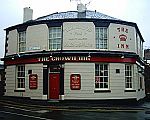St Peter, Greenhill
20th-century Church of England church buildingsChurch of England church buildings in South YorkshireChurches completed in 1965Churches in SheffieldEnglish church stubs

St Peter's Greenhill is a Parish Church in the Church of England Diocese of Sheffield located in the Greenhill area of the city.The church was built between 1964 and 1965 to serve the housing development that was built at what was then the edge of Sheffield. Prior to the construction of the church, the local population were served by the church of St James, Norton. The church was designed by Oxley and Bussey, and it was consecrated by the Bishop of Derby in May 1965.The church was designated a Grade II listed building in 1999.
Excerpt from the Wikipedia article St Peter, Greenhill (License: CC BY-SA 3.0, Authors, Images).St Peter, Greenhill
Angerford Avenue, Sheffield Norton Lees
Geographical coordinates (GPS) Address Nearby Places Show on map
Geographical coordinates (GPS)
| Latitude | Longitude |
|---|---|
| N 53.35 ° | E -1.473 ° |
Address
St Paul's
Angerford Avenue
S8 9BB Sheffield, Norton Lees
England, United Kingdom
Open on Google Maps








